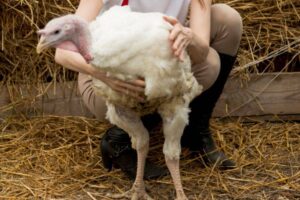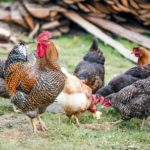Table of Contents
Understanding the signs that indicate a turkey is about to lay eggs can be incredibly useful for anyone raising these magnificent birds.

Whether you’re a backyard hobbyist or a commercial farmer, being able to predict when your turkeys will start laying can help with planning and managing your flock.
This article will provide an in-depth look into these signs, explaining how to recognize each one.
Physical Changes in the Turkey
Increased Size and Weight
One of the first physical signs that a turkey hen is about to lay eggs is an increase in size and weight. As the bird’s body prepares for egg production, she may become noticeably heavier.
This is due to the development of the reproductive organs and the formation of eggs within her body.
Checking your turkey regularly and being familiar with her normal weight will help you notice any significant changes.
Changes in the Vent Area
Another physical sign is changes in the vent area. The vent, or cloaca, is the external opening that serves as the exit for the reproductive, digestive, and urinary systems in birds.
When a turkey is close to laying, the vent becomes larger, moister, and lighter in color. This is due to the increased blood flow to the area and the stretching of the muscles in preparation for egg-laying.
Behavioral Changes
Nesting Behavior
Turkeys, like many birds, exhibit specific nesting behaviors when they are about to lay eggs.
You may notice your turkey spending more time in secluded areas, especially if there’s a comfortable spot with plenty of straw or other soft materials.
She may start arranging the materials, creating a cozy nest where she’ll lay her eggs.
Increased Vocalization
Turkeys are known for their vocalizations, but when a hen is about to lay, she may become even more vocal. She might make specific sounds that are different from her usual calls.
This is a way of communicating with the rest of the flock, signaling her intent to lay eggs.
Dietary Changes
Increase in Food Intake
As the energy requirements for egg production are high, a turkey hen about to lay eggs often shows an increase in food intake.
She needs more nutrients to produce eggs, so she will spend more time eating. Providing a balanced diet rich in calcium and other essential nutrients is crucial during this period.
Changes in Water Consumption
Along with increased food intake, a turkey about to lay eggs may also consume more water. Hydration is essential for egg formation, especially for the development of the egg white, which is mostly water.
Changes in Movement

Decreased Activity Levels
When a turkey is about to lay eggs, you might notice a decrease in her activity levels.
She may seem less interested in exploring or foraging and spend more time resting or staying near her chosen nesting spot. This change is part of her body’s way of conserving energy for egg production.
Frequent Squatting
Frequent squatting is another sign that a turkey is about to lay. This behavior is related to the changes in the vent area as the body prepares for egg-laying.
The turkey may squat and strain as if trying to lay an egg, even before the first egg comes.
Interaction with Other Turkeys
Aggression Towards Other Turkeys
A turkey hen getting ready to lay eggs may become more aggressive or territorial. This behavior is especially noticeable if she has chosen a nesting spot.
She may peck or chase away other birds that come too close to her nest, protecting her space and the future eggs.
Separation from the Flock
Another behavior change that can indicate impending egg-laying is separation from the flock. A turkey hen about to lay eggs often prefers solitude.
She may move away from the rest of the flock, especially when she’s ready to lay her eggs.
Egg-Laying Patterns
Predictable Laying Schedule
Once a turkey hen starts laying eggs, she usually follows a predictable schedule. Most turkey hens lay an egg every other day.
If you notice your turkey has started a regular pattern of disappearing and reappearing, she may be laying eggs in a hidden location.
Irregular Egg-Laying
However, not all turkeys follow the every-other-day rule. Some turkeys may lay eggs irregularly, especially when they first start laying.
Stress, environmental changes, or health issues can also cause irregularities in egg-laying.
Environmental Factors
Suitable Nesting Environment
The environment plays a significant role in stimulating egg-laying in turkeys. A turkey hen needs a quiet, secluded spot with soft materials for her nest.
If such a spot is available and your turkey has been showing other signs of impending egg-laying, the stage is set for her to start laying eggs.
Weather Conditions Impact
Weather conditions can also affect when a turkey will start laying eggs. Turkeys usually start laying in the spring when the days start getting longer.
Sudden changes in weather can delay egg-laying, while consistent, favorable weather conditions can encourage it.
Changes in Feather Condition

Loss of Feathers around the Vent Area
When a turkey is about to lay eggs, one of the signs you may notice is the loss of feathers around the vent area.
This is quite normal and is often due to the turkey herself plucking them out to line her nest. It can also be a result of the increased activity of the vent area during egg-laying.
Changes in Feather Quality
The quality of a turkey’s feathers can also change when she’s about to start laying eggs. She may show dull, ragged, or broken feathers, especially around the back end.
This is because a lot of the nutrients that would normally go to feather maintenance are instead being diverted to egg production.
Increase in Droppings
Larger, More Frequent Droppings
An increase in the size and frequency of droppings can be another sign that a turkey is about to lay eggs.
This is because the bird’s food and water intake increases during this period, leading to more waste production.
Changes in Dropping Consistency
You might also notice changes in the consistency of the droppings. They may become more watery due to the increased water intake necessary for egg formation.
However, if the droppings are excessively watery, or if they contain blood or are of an unusual color, it could indicate a health problem, and a vet should be consulted.
Conclusion
Recognizing the signs that a turkey is about to lay eggs allows for better care and management of your flock.
By observing their physical changes, behaviors, dietary habits, movement patterns, interactions, and egg-laying patterns, you can anticipate when a turkey is about to lay eggs and ensure they are provided with the right conditions for successful egg-laying.
Understanding these signs not only enhances your turkey-raising experience but also ensures the health and productivity of your birds.




